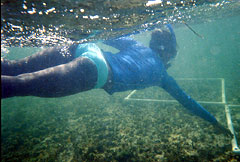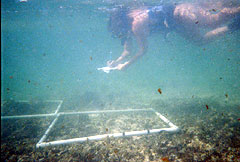

 | |||||||||||||
|
|
Journals 2005/2006Greer Harvell
July 8, 2005 Today it was my duty to assist Sherry in her research. Sherry is a 29 year old grad student under Dr. Sealy from St. Lucia's Island researching parrot fish. Her method for today's study was to assemble two squares from PVC pipe approximately 1 1/2 inch in diameter. Each pipe measures 1 meter in length. When each square had been assembled, she placed them together underwater with the top right vertex of one square touching the bottom left vertex of the other square. This arrangement laid out the parameter for the area she would be observing (2.5 sq. meters). Setting the timer for 10 minutes, we observed the area and noted the size and type of fish in the area for that time frame. (I had never used underwater paper before-what a great idea). The weather conditions were very rough; we were experiencing some affects from Hurricane Dennis. Sherry appeared unaffected by the strong currents and choppy waves however, and that helped me to not over react to the conditions.
Sherry moved the quadrant a total of 8 times. Each time she moved, she showed me how she sketched the coastline, so that she would be able to better record her data at a later date. Not every site was very productive, and during the "down" time, she helped me to identify the numerous species of marine life that live in these waters. She also explained that she and the rest of the staff share their data with one another. For example, she needs to note the weather conditions, tide, and water quality when recording her fish survey. Weather conditions and tide she gets on her own, but she gets the information for water quality (salinity, temperature, and visibility) from Emily, an undergrad student also working with Dr. Sealy who is in charge of tracking water quality during our stay here. It is very refreshing to see individuals so willing to help each other-the atmosphere between the staff is that of cooperation and collaboration. Each staff member who has reached a certain point in their work with Dr. Sealy has chosen what they will be performing research on. For Sherry it is parrot fish, Kate is corals, etc. I wasn't really clear how their research fit in with the big picture (Baker's Bay development), but Sherry explained that their data would be compiled and used as a baseline study of the coastal ecology prior to the development. They will continue to monitor the site, and will be able to document what affect, if any, the development will have on the ecology. |
||||||||||||

